From a few hundred metres up, the Ukrainian countryside beyond the Russian frontline is beautiful. Thousands, perhaps millions, of wild delphinium flowers paint the prairie-sized meadows below with a blue‑purple blush. Other fields are saturated with the yellow blooms of bedstraw.
‘Eight hundred metres to target,’ says Kus, crouching beside me. His comrade, Umbrella, moves the control stick a fraction. The fibre optic drone’s altitude begins to decrease.
Now we start to see the ugly pock marks, the countless shell holes, the contagion of war. I’m gripped by an anticipation which is close to fear.
Three young men in this claustrophobic dugout are trying to kill another group of young men in a similar hole in the ground, a few miles away. The attempt is being livestreamed onto the laptop screen in front of me.
Retaliation is almost inevitable.
Minutes earlier, Puma, sitting near the dugout entrance, gave a sharp hiss and raised his hand for silence. Into it swelled the flesh-creeping buzz of a kamikaze drone, which passed low and fast over our position.
Russian or Ukrainian? Puma did not know. The sky around here is too saturated with these machines for every one of them to be identified as friend or foe.
Beyond any doubt though, the hunters and the hunted are locked in a kill-or-be-killed fight for battlefield supremacy.
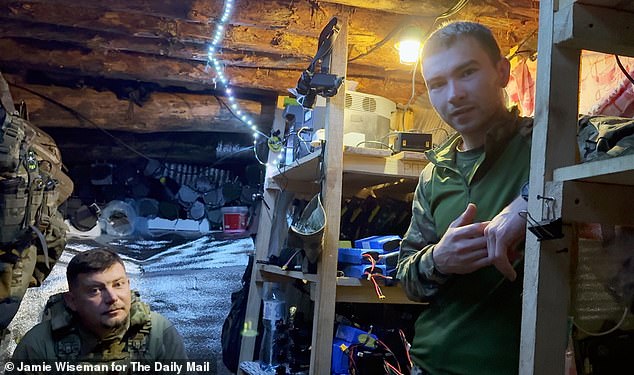
In Eastern Ukraine, Pendlebury and Wiseman accompany troops to watch their new weapon in action. ‘Puma’ and Richard’s military escort Stas are pictured
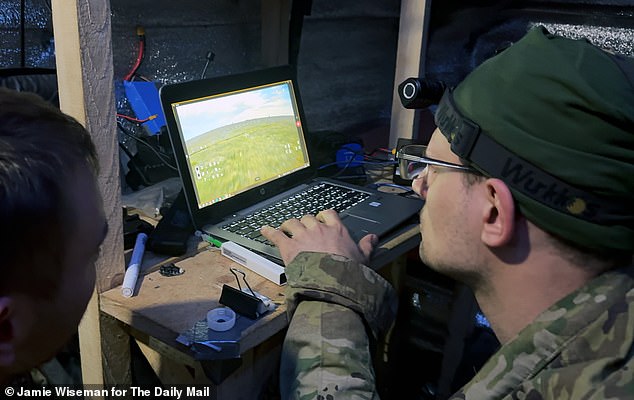
Kus monitors the feed of their drone from the bunker while another soldier controls it
The Ukrainian twentysomethings I am with are an elite team, flying a new weapon which is changing the face of warfare.
Until a few months ago, all FPV – first person view – suicide drones were controlled by radio signals, which could be jammed by an enemy’s electronic warfare (EW) systems.
No longer. The unmanned aerial vehicles (UAVs) being launched from this dugout are piloted via ten kilometres of gossamer-thin fibre optic cable, carried under the drone in a spool.
This physical connection – like that of a kite-flyer to his kite – through which the control signals travel, means the weapon is immune to electronic warfare. In other words, ‘un-jammable’. And very much feared as a result.
There is a further dystopian twist to this leap in technology.
Aside from the explosive damage, fibre optic drone warfare is changing the appearance of the countryside in an unexpected way.
For miles around our position, fields, treetops, and hedgerows have begun to glint and glisten strangely in the sunlight. The glittering sheen is caused by the thousands of individual fibre optic cables which were unwound during suicide drone missions and left discarded where they fell.
Like a gigantic spider’s web, these artificial threads make the passage of wheeled military vehicles increasingly difficult. The cables wind themselves about axles and clog drivetrains. It’s as if both sky and land has been cursed.
Certainly, Umbrella, Kus and Puma, and their Russian counterparts, have cast a new sense of dread along the entire 1,000km frontline. No poor bloody infantryman dares show himself, without vital reason, lest another cable begins to unwind in his direction.
The 13th ‘Khartiia’ Brigade of the National Guard – one of the most innovative formations in the Ukrainian military – is at the forefront of this development in combat.
Earlier this year, photographer Jamie Wiseman and I spent time with Khartiia’s extraordinary robot dogs and other cutting-edge ground drones.
This week the Mail was invited back, to witness the brigade’s fibre optic drone units in frontline action. I was to spend 48 hours with them – the first journalist to do so – in the heart of the ‘kill zone’.
Before that could happen however, there was the fraught challenge of reaching their dugout.
It’s still some hours before sunrise. In summer, the nights are never truly dark, but this is as close as we will get to Nature’s concealment.
I’m being given a ride in a Khartiia pickup truck that’s going to collect the crew of a Vampire heavy drone unit based near the fibre optic pilots. My driver’s call sign is Driver, which makes me think of Major Major in Catch-22.
On his last trip, Driver Driver’s truck was hit and disabled by an FPV. The shattered windscreen of his current mount looks like it was also struck by some missile, although on that occasion it didn’t explode.
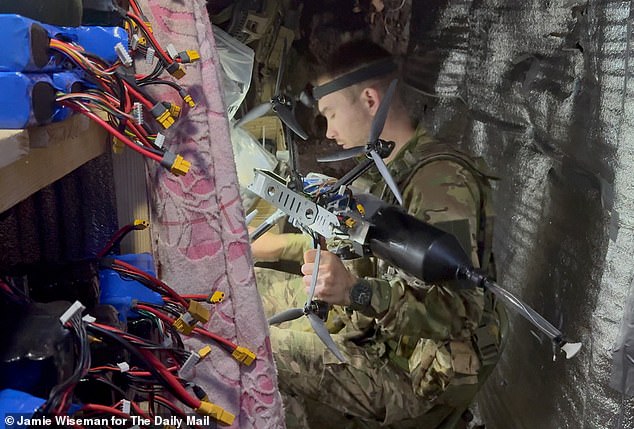
Puma prepares a drone for their next mission from the secret location
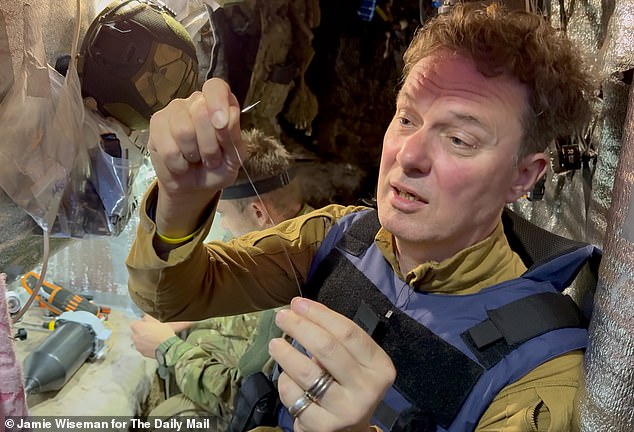
Richard Pendlebury examines a length of the fibre optic cable used in the drones
Without lights, he takes us at speed along military tracks, narrow rural lanes and through a ruined village. As the sky lightens, I’m startled to see a drone fly past our truck only 40 metres away, going in the opposite direction.
It’s a Ukrainian Vampire, Driver assures me. Then we pass the burned-out wreck of a pickup which was caught by an enemy drone on its way back from the frontline.
Forty-five minutes later, we embark on the final leg.
Driver reverses into a thicket and calls ahead on a walkie talkie. Yes, the sky is clear of drones at our destination.
He switches on the truck’s EW drone-jamming system. We accelerate out of cover, up a lane and then, bone-shakingly, into the open fields.
We halt again by a treeline. Figures emerge from the shadows, as an artillery shell crashes nearby. These wraiths are the departing Vampire crew.
Imagine an F1 pit stop, and you will get something of the sense of urgency. This is the moment of greatest peril, when a stationary target is offered up to the enemy. A Vampire which needs repair is carried at a trot from the trees by two soldiers and placed onto the truck’s flat bed.
Also at a run, I am led by a soldier the other way, into the gloom and quasi-sanctuary of the wood.
Our route winds for several hundred metres between trees and undergrowth until the guide steps off the track and we descend into a well-concealed trench.
Beyond a camouflage curtain and a metal door, I find myself in a concrete-lined storage bunker. This will be my sleeping quarters.
Mosquitoes buzz in the torchlight and I hear the dawn chorus through a ventilation shaft, while the slam of artillery is as regular as a church clock . The ‘zero point’ – the frontline – is less than two miles away. There is no electricity. This could be Flanders a century ago.
Full daylight arrives.
Stas – my military escort – and I and are collected by Puma, one of the fibre optic pilots, and led at a run further along the treeline. Songbirds are in full voice and butterflies flit, but this is a battlefield. We pass a crater where a heavy mortar shell has landed. An unexploded bomb is lying in the grass beside the path, probably dropped by a Russian Mavic drone. Anti-suicide drone netting lines the edges of the wood.
A landscape which should be beautiful has become sinister.
Suddenly, Puma stops, crouches and lifts a section of what had looked like the forest floor. One by one we disappear through the trapdoor into a subterranean hideout.
Hiding is exactly what these pilots must do to stay alive. Aside from launching their one-way drones, and calls of nature, theirs is a troglodyte existence.
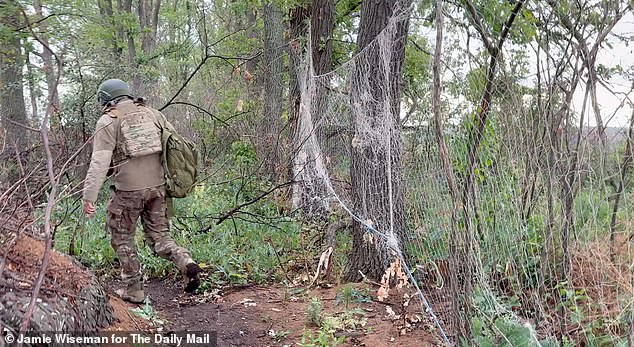
Along the frontline, netting is used as a flimsy protection against the enemy’s drones
Their commander, Hlyba, has already explained this to me: ‘Right now, for both sides, the drone pilots are the number one targets because they cause the most damage,’ he says.
Lined with tree trunks, the bunker is home to Puma, Umbrella and Kus. Puma is wiry, garrulous. Umbrella, handsome, a little shy. Kus, bespectacled studious. All have a background in engineering or IT.
For the moment, they live and work in a tiny room, which they share with two bunks, shelves of batteries, drone parts and munitions, a small stove to heat their food and drink, a folding chair, two stools and a table upon which the laptop sits. The latter is their vital window into the world above.
On a digital map, the surrounding woods and copses are delineated in turquoise. The warring ground forces are all contained within these shapes.
No position could survive without the cover of a tree canopy, thanks to the drone threat. Russian infantry has taken to marching for miles to the front, like their Napoleonic forebears, rather than ride in vehicles which are the fibre optic pilots’ favourite targets.
But today, the nervous foot sloggers are quite safe.
For hours, an unseasonal breeze has been blustering through the wood above us. Fibre optic drones are sensitive craft and don’t perform well in a windspeed of above ten metres per second. It’s now blowing at 15 metres, says Puma. Missions are suspended until the wind eases.
By afternoon, the wind has only increased. Night draws on and still no action.
Puma, a chess fanatic, is playing a game on his phone with a remote opponent. ‘He has conceded,’ he announces, at last, with satisfaction. At 2am we retire to our mouse dropping-covered mattresses and sleep.
Three hours later, I wake to the sound of a drone loitering along our treeline. Presently, the sound recedes. More lightless confinement passes.
In the afternoon I venture onto the step of the dugout to enjoy the dabbled sunlight through the camo netting. But almost at once, bursts of machine gun fire from further down the trench persuade me inside again. The men are shooting at another strange drone, while the crump of artillery has also increased in tempo.
The war seems to be hotting up in our sector, but still the fibre optic machines are grounded by the breeze.
Stas says: ‘It should be a comfort to you that if Russia decides to conquer the whole of Europe, you British on your windy island will not have to worry about this wonder weapon for more than ten days every year!’
Then, as evening approaches, the orders change. The drone crew must prepare to launch an attack. Frantic activity in the hideout.
First, a drone is taken from a shelf. With practised speed, the battery is tested and the warhead – a landmine – attached. The end of the fibre optic cable is then teased out of the spool and through a pipe and connected to the drone-controlling handset. This is held by Umbrella, the designated mission pilot.
He has already donned VR googles, through which he will see the live feed from the drone’s video camera.
A Vampire drone has already bombed the target, a Russian FPV dugout in the middle of a wood. But headquarters are not satisfied with the results. They want a fibre optic kamikaze to go in and finish the job.
A Mavic drone will conduct another reconnaissance over the target area. Then it’s Umbrella’s turn, at low level.
First, the commander wants them to find a suspected second Russian bunker in the same wood. After that, they are to detonate the drone on the FPV dugout. Real time footage from the hovering Mavic now appears on the laptop.
In the middle of a dark green wood, a clearing has been made by the explosion of the Vampire’s bomb. Several young trees have been felled. They appear to have fallen across the target dugout. It will make the fibre optic attack trickier.
Puma carries the drone out of the dugout to the launch site and arms the warhead. The trailing optic cable has been taped against the plastic covered walls of the tunnel, to avoid snagging.
Under Umbrella’s control, the drone leaves the ground and heads north on its suicidal task.
The floral countryside rushes by on the laptop screen, with Kus providing commentary.
Umbrella pilots the drone beyond the target wood, then performs a gentle turn and descends into the clearing. Very carefully, he pilots the drone to a couple of metres from the ground and slaloms slowly between sapling trunks. Can the Russians in the dugout hear the drone as it approaches for the kill, as we heard the drone over us the day before? On the screen, leaves flutter in the quadcopter’s backwash.
The squad think they can see a second dugout. The delicacy of the manoeuvring is impressive. But this is the antithesis of the fibre optic drone’s optimal environment.
Inevitably, perhaps, the drone catches on a twig or branch and falls. Umbrella remotely explodes the warhead. The live footage from the Mavic shows a cloud of white smoke rise from the clearing.
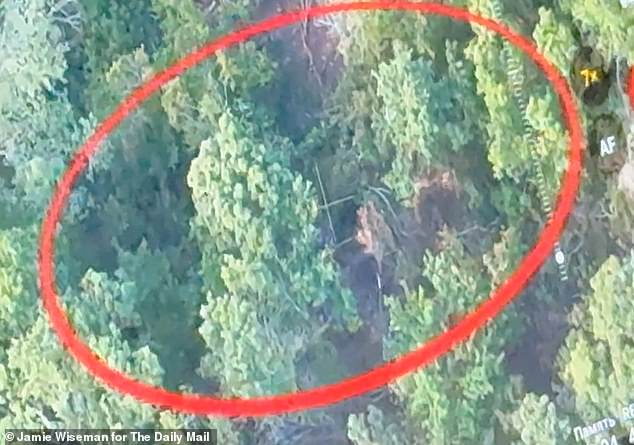
A surveillance drone, manned by Umbrella, identifies the target
A second fibre optic drone is launched. Umbrella is instructed to simply to attack the first enemy dugout.
Again, he lowers the drone into the clearing. But at the last moment he must turn it sharply and the delicate cable snaps. Control is lost. The drone falls to earth.
Yet all is not lost.
The Mavic feed shows the kamikaze drone has landed on top of the target. The warhead has a timer, set to explode in 20 minutes if pilot contact is lost.
But I must leave before it does so. A new Vampire crew is arriving at the treeline on the next rotation run.
Kus leads the way through the gloaming, clutching a bag of dugout rubbish which can’t be dumped or burned here lest it attracts Russian interest.
We find the replacement drone crew already disembarked on the edge of the wood.
‘Come on, come on guys, hurry,’ someone is urging. Supplies and equipment are being hustled off the flat bed. The bag of rubbish and my kit replaces them. We leave.
For the first quarter hour, we move agonisingly slowly over open fields, with no headlights and my sense of impending doom. Yet the driver unerringly negotiates a complex, switchback route in the gathering darkness
Only after 25 minutes does he dare switch on sidelights. Not for another ten after that does he remove his helmet.
The kill zone is behind us. But the chilling fibre optic war goes on.











